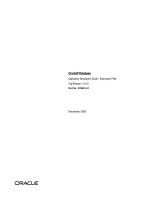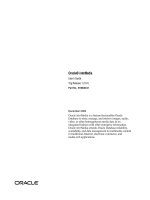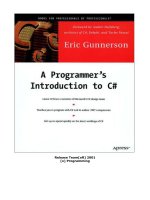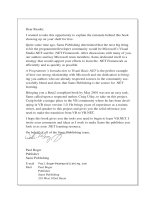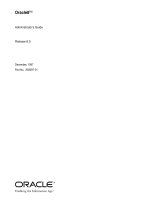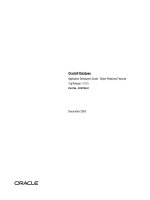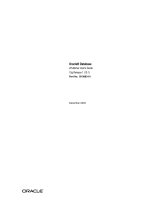Tài liệu Todd Lammle’s CCNA ® IOS ® Command Survival Guide pptx
Bạn đang xem bản rút gọn của tài liệu. Xem và tải ngay bản đầy đủ của tài liệu tại đây (7.18 MB, 315 trang )
Wiley Publishing, Inc.
Todd Lammle’s
CCNA
®
IOS
®
Command
Survival Guide
Todd Lammle
75606ffirs.fm Page i Tuesday, October 23, 2007 3:24 PM
75606ffirs.fm Page vi Tuesday, October 23, 2007 3:24 PM
Wiley Publishing, Inc.
Todd Lammle’s
CCNA
®
IOS
®
Command
Survival Guide
Todd Lammle
75606ffirs.fm Page i Tuesday, October 23, 2007 3:24 PM
Acquisitions Editor: Jeff Kellum
Development Editor: Lisa Thibault
Technical Editor: Patrick J. Conlan
Production Editor: Eric Charbonneau
Copy Editor: Kim Wimpsett
Production Manager: Tim Tate
Vice President and Executive Group Publisher: Richard Swadley
Vice President and Executive Publisher: Joseph B. Wikert
Vice President and Publisher: Neil Edde
Compositor: Craig Johnson, Happenstance Type-O-Rama
Proofreader: Amy McCarthy
Indexer: Ted Laux
Anniversary Logo Design: Richard Pacifico
Cover Designer: Ryan Sneed
Copyright © 2008 by Wiley Publishing, Inc., Indianapolis, Indiana
Published by Wiley Publishing, Inc., Indianapolis, Indiana
Published simultaneously in Canada
ISBN: 978-0-4701-7560-6
No part of this publication may be reproduced, stored in a retrieval system or transmitted in any form or by any means,
electronic, mechanical, photocopying, recording, scanning or otherwise, except as permitted under Sections 107 or
108 of the 1976 United States Copyright Act, without either the prior written permission of the Publisher, or autho-
rization through payment of the appropriate per-copy fee to the Copyright Clearance Center, 222 Rosewood Drive,
Danvers, MA 01923, (978) 750-8400, fax (978) 646-8600. Requests to the Publisher for permission should be
addressed to the Legal Department, Wiley Publishing, Inc., 10475 Crosspoint Blvd., Indianapolis, IN 46256, (317)
572-3447, fax (317) 572-4355, or online at />Limit of Liability/Disclaimer of Warranty: The publisher and the author make no representations or warranties with
respect to the accuracy or completeness of the contents of this work and specifically disclaim all warranties, including
without limitation warranties of fitness for a particular purpose. No warranty may be created or extended by sales or
promotional materials. The advice and strategies contained herein may not be suitable for every situation. This work
is sold with the understanding that the publisher is not engaged in rendering legal, accounting, or other professional
services. If professional assistance is required, the services of a competent professional person should be sought. Nei-
ther the publisher nor the author shall be liable for damages arising herefrom. The fact that an organization or Website
is referred to in this work as a citation and/or a potential source of further information does not mean that the author
or the publisher endorses the information the organization or Website may provide or recommendations it may make.
Further, readers should be aware that Internet Websites listed in this work may have changed or disappeared between
when this work was written and when it is read.
For general information on our other products and services or to obtain technical support, please contact our
Customer Care Department within the U.S. at (800) 762-2974, outside the U.S. at (317) 572-3993 or fax
(317) 572-4002.
Wiley also publishes its books in a variety of electronic formats. Some content that appears in print may not be
available in electronic books.
Library of Congress Cataloging-in-Publication Data is available from the publisher.
TRADEMARKS: Wiley, the Wiley logo, and the Sybex logo are trademarks or registered trademarks of John Wiley
& Sons, Inc. and/or its affiliates, in the United States and other countries, and may not be used without written per-
mission. CCNA and IOS are registered trademarks of Cisco Systems, Inc. All other trademarks are the property of
their respective owners. Wiley Publishing, Inc., is not associated with any product or vendor mentioned in this book.
10 9 8 7 6 5 4 3 2 1
75606ffirs.fm Page ii Tuesday, October 23, 2007 3:24 PM
Dear Reader
Thank you for choosing
Todd Lammle’s CCNA IOS Command Survival Guide.
This book
is part of a family of premium quality Sybex books, all written by outstanding authors who
combine practical experience with a gift for teaching.
Sybex was founded in 1976. More than thirty years later, we’re still committed to producing
consistently exceptional books. With each of our titles we’re working hard to set a new stan-
dard for the industry. From the paper we print on, to the authors we work with, our goal
is to bring you the best books available.
I hope you see all that reflected in these pages. I’d be very interested to hear your comments
and get your feedback on how we’re doing. Feel free to let me know what you think about
this or any other Sybex book by sending me an email at
, or if you think
you’ve found a technical error in this book, please visit
.
Customer feedback is critical to our efforts at Sybex.
Best regards,
Neil Edde
Vice President and Publisher
Sybex, an Imprint of Wiley
75606ffirs.fm Page iii Tuesday, October 23, 2007 3:24 PM
Acknowledgments
Kudos to Jeff Kellum for coming up with the idea for this book. This was one of my favorite
books I have written.
Thanks to Lisa Thibault for her patience and gentle but effective direction and also thanks
to Eric Charbonneau for helping me organize and keep my thoughts going in one direction—
which is no easy task! Also, thanks to Pat Conlan for his technical expertise. Finally, thanks
to copy editor Kim Wimpsett, proofreader Amy McCarthy, and compositor Craig Johnson;
all of who helped to create this fantastic title.
About the Author
Todd Lammle, CCSI, CCNA/CCNP/CCSP, MCSE, CEH/CHFI, FCC RF Licensed, is the
authority on Cisco Certification internetworking. He is a world renowned author, speaker,
trainer and consultant. Todd has over 25 years of experience working with LAN’s, WAN’s
and large licensed and unlicensed Wireless networks. He is president of GlobalNet Training
and Consulting, Inc., a network integration and training firm based in Dallas. You can reach
Todd through his forum at
www.lammle.com
.
75606ffirs.fm Page iv Tuesday, October 23, 2007 3:24 PM
Contents at a Glance
Introduction xiii
Chapter 1
Basic IOS Commands 1
Chapter 2
Managing a Cisco Internetwork 21
Chapter 3
IP Routing 57
Chapter 4
Enhanced IGRP (EIGRP) and Open Shortest Path First (OSPF) 75
Chapter 5
Layer-2 Switching and Spanning-Tree Protocol (STP) 101
Chapter 6
Virtual LANs (VLANs) 121
Chapter 7
Security 137
Chapter 8
Network Address Translation (NAT) 161
Chapter 9
Cisco’s Wireless Technologies 175
Chapter 10
Internet Protocol Version 6 (IPv6) 199
Chapter 11
Wide Area Networks (WANs) 219
Chapter 12
Cisco’s Security Device Manager (SDM) 249
Index 279
75606ffirs.fm Page v Tuesday, October 23, 2007 3:24 PM
75606ffirs.fm Page vi Tuesday, October 23, 2007 3:24 PM
Contents
Introduction xiii
Chapter 1 Basic IOS Commands 1
Booting the Router 2
Setup Mode 4
Router Configuration Modes 4
Editing and Help Features 6
Configuring a Router 9
Hostnames 9
Banners 9
Passwords 10
Router Interfaces 14
Using the
show
Command 18
Chapter 2 Managing a Cisco Internetwork 21
Understanding the Internal Components of a Cisco Router 22
Managing the Configuration Register 23
Checking the Current Configuration Register Value 24
Changing the Configuration Register 24
Recovering Passwords 26
Using Boot System Commands 29
Backing Up and Restoring the Cisco IOS 30
Verifying Flash Memory 30
Backing Up the Cisco IOS 31
Restoring or Upgrading the Cisco Router IOS 32
Using the Cisco IOS File System (Cisco IFS) 32
Backing Up and Restoring the Cisco Configuration 35
Backing Up the Cisco Router Configuration 35
Restoring the Cisco Router Configuration 37
Erasing the Configuration 38
Using the Cisco IOS File System to Manage
Your Router’s Configuration (Cisco IFS) 38
Using Cisco Discovery Protocol (CDP) 40
Getting CDP Timers and Holdtime Information 40
Gathering Neighbor Information 41
Gathering Interface Traffic Information 43
Gathering Port and Interface Information 43
75606ftoc.fm Page vii Tuesday, October 23, 2007 3:25 PM
viii
Contents
Using Telnet 44
Telnetting into Multiple Devices Simultaneously 45
Checking Telnet Connections 46
Checking Telnet Users 46
Closing Telnet Sessions 47
Resolving Hostnames 48
Building a Host Table 49
Using DNS to Resolve Names 51
Checking Network Connectivity and Troubleshooting 52
Using the
ping
Command 52
Using the
traceroute
Command 53
Debugging 53
Using the
sh processes
Command 55
Chapter 3 IP Routing 57
Routing Basics 58
Static Routing 61
Default Routing 63
Routing Protocol Basics 65
Administrative Distances (ADs) 65
Routing Information Protocol (RIP) 66
RIP Timers 67
Enabling RIP 68
Holding Down RIP Propagations 69
RIP Version 2 (RIPv2) 69
Verifying RIP 71
The
show ip protocols
Command 71
The
debug ip rip
Command 72
Chapter 4 Enhanced IGRP (EIGRP) and
Open Shortest Path First (OSPF) 75
Understanding EIGRP Basics 76
Configuring EIGRP 77
Holding Down EIGRP Propagations 77
Setting Maximum Paths and Hop Count 78
Using Redistribution Commands 79
Configuring Discontiguous Networks 81
Load Balancing with EIGRP 81
Using Route Authentication with EIGRP 85
Verifying EIGRP 86
Understanding Open Shortest Path First (OSPF) Basics 90
Configuring OSPF 91
Enabling OSPF 92
Configuring OSPF Areas 92
75606ftoc.fm Page viii Tuesday, October 23, 2007 3:25 PM
Contents
ix
Verifying OSPF Configuration 92
Using the
show ip ospf
Command 94
Using the
show ip ospf database
Command 95
Using the
show ip ospf interface
Command 95
Using the
show ip ospf neighbor
Command 96
Using the
show ip protocols
Command 97
Debugging OSPF 98
Chapter 5 Layer-2 Switching and
Spanning-Tree Protocol (STP) 101
Switching Services 102
Three Switch Functions at Layer 2 103
Basic Switch Configurations 104
Switch Security 105
Spanning-Tree Operations 107
Optimizing Spanning-Tree Operations 108
EtherChannel 112
Verifying Cisco Catalyst Switches 114
Chapter 6 Virtual LANs (VLANs) 121
Understanding VLAN Basics 122
Configuring VLANs 122
Verifying VLAN Creation 124
Assigning Switch Ports to VLANs 124
Configuring Trunk Ports 126
Configuring Inter-VLAN Routing 130
Configuring VTP 131
Telephony: Configuring Voice VLANs 134
Configuring the Voice VLAN 134
Chapter 7 Security 137
Perimeter Routers, Firewalls, and Internal Routers 138
Recognizing Security Threats 139
Using Cisco IOS Firewall 140
Introduction to Access Lists 141
Standard Access Lists 143
Wildcard Masking 145
Controlling VTY (Telnet) Access 145
Extended Access Lists 146
Named Access Lists 151
Switch Port ACLs 153
Time-Based ACLs 156
Monitoring Access Lists 158
75606ftoc.fm Page ix Tuesday, October 23, 2007 3:25 PM
x
Contents
Chapter 8 Network Address Translation (NAT) 161
When Do We Use NAT? 162
Types of Network Address Translation 163
NAT Names 164
Static NAT Configuration 165
Dynamic NAT Configuration 166
PAT (Overloading) Configuration 167
Simple Verification of NAT 168
Configuring NAT Using SDM 170
Chapter 9 Cisco’s Wireless Technologies 175
Introducing Wireless Technology 176
The 802.11 Standards 178
Service Sets 182
Wireless Security 184
Configuring Cisco Wireless Using the IOS 186
AP Configuration 189
Configuring Cisco Wireless Using the SDM/HTTP 190
Chapter 10 Internet Protocol Version 6 (IPv6) 199
Why Do We Need IPv6? 200
IPv6 Addressing and Expressions 201
Shortened Expression 202
Configuring Cisco Routers with IPv6 203
DHCPv6 204
IPv6 Routing Protocols 206
RIPng 206
EIGRPv6 207
OSPFv3 208
Migrating to IPv6 209
Dual Stacking 210
6to4 Tunneling 211
Verifying RIPng 212
Verifying OSPFv3 215
Chapter 11 Wide Area Networks (WANs) 219
Introduction to Wide Area Networks 220
Defining WAN Terms 221
WAN Support 221
High-Level Data-Link Control (HDLC) Protocol 224
75606ftoc.fm Page x Tuesday, October 23, 2007 3:25 PM
Contents
xi
Point-to-Point Protocol (PPP) 225
Configuring PPP on Cisco Routers 226
Configuring PPP Authentication 227
Verifying PPP Encapsulation 228
PPPoE Configuration 233
Introduction to Frame Relay Technology 235
Frame Relay Encapsulation Types 236
Data Link Connection Identifiers (DLCIs) 237
Local Management Interface (LMI) 238
Frame Relay Implementation and Monitoring 241
Chapter 12 Cisco’s Security Device Manager (SDM) 249
Configuring Your Router to Be Set Up Through the SDM 250
Using the SDM to Manage the Flash Memory 259
Using the SDM to Back Up, Restore, and Edit the
Router’s Configuration 262
Configuring LAN and Wan Interfaces and Verifying a
Router Using SDM 266
Configuring RIP on a Router with SDM 272
EIGRP 274
Configuring OSPF with the SDM 275
Index 279
75606ftoc.fm Page xi Tuesday, October 23, 2007 3:25 PM
75606ftoc.fm Page xii Tuesday, October 23, 2007 3:25 PM
Introduction
I know it’s kind of wrong to say this type of stuff about your own stuff, but I’m just going to
do it—this is a really good book! It might even be the most interesting book I’ve written so far.
A big reason for this is that its scope allowed me to go above and beyond covering the usual
CCNA study guide material and really detail the commands I used in the guide, plus a lot of
additional commands that just happen to be some of my personal favorites.
Do remember that, although very cool indeed, this volume isn’t intended to be a one-stop
shop for passing the CCNA exams. Think of it and use it as a supplement to other study mate-
rial—like, well, my Sybex CCNA study guide! But seriously, I want you to know that this
book will complement anything no matter what you have stashed in your personal arsenal to
pass the exams—it’s that good, and yes, I said it myself. By the way, know that lots of other
people (who I didn’t pay) think so too!
How to Use This Book
If you want a solid foundation for the serious and I hope successful goal of effectively prepar-
ing for the Cisco Certified Network Associate (CCNA) suite of exams—including the ICND1,
ICND2, and the CCNA composite 640-802—then this is your baby! I’ve spent hundreds of
hours putting together this book with the sole objective of helping you to pass the whole group
of CCNA exams while actually learning learn how to configure Cisco routers, switches, and
tons of other things too.
So, yes, this book is loaded with lots of valuable information, and you will get the most out
of all that and your studying time if you understand how I put the book together.
To maximize your benefit from this book, I recommend the following study method:
1.
My recommendation is to read the full Sybex
CCNA Study Guide Sixth Edition
and then
just start reading this book from Chapter 1 and don’t stop until your all the way through
Chapter 12. This study method will really help you concentrate on the command needed
to cover the many CCNA objectives.
2.
Study each chapter carefully, making sure you fully understand the command covered in
each chapter. Pay extra-close attention to any chapter that includes material covered you
struggled with when reading the full study guide.
3.
Check out www.lammle.com
for more Cisco exam prep questions and updates to this
book and other Cisco books I have written. The questions found at
www.lammle.com
will
be updated at least monthly, if not weekly or even daily! Before you take your test, be sure
and visit my website for questions, videos, audios, and other useful information.
4.
Make sure you download any new PDF files found at
www.lammle.com
or
www.sybex.com/
go/IOS
so you have the latest technical information covered by the latest CCNA objectives.
To learn every bit of the material covered in this book, you’ll have to apply yourself regu-
larly and with discipline. Try to set aside the same time period every day to study, and select
75606flast.fm Page xiii Tuesday, October 23, 2007 3:27 PM
xiv
Introduction
a comfortable and quiet place to do so. If you work hard, you will be surprised at how quickly
you learn this material.
What Does This Book Cover?
This book covers everything you need to know in order to understand the CCNA exam
objective commands. However, taking the time to study and practice with routers or a router
simulator is the real key to success.
You will learn the following information in this book:
Chapter 1 introduces you to the Cisco Internetwork Operating System (IOS) and
command-line interface (CLI). In this chapter you will learn how to turn on a router and con-
figure the basics of the IOS, including setting passwords, banners, and more. IP configu-
ration using the Secure Device Manager (SDM) will be discussed in Chapter 12.
Chapter 2 provides you with the management skills needed to run a Cisco IOS network.
Backing up and restoring the IOS, as well as router configuration, are covered, as are the
troubleshooting command tools necessary to keep a network up and running. Chapter 12
will provide you the SDM configuration covered in this chapter.
Chapter 3 teaches you about IP routing. This is an important chapter, because you will learn
how to build a network, add IP addresses, and route data between routers. You will also
learn about static, default, and dynamic routing using RIP and RIPv2 (with a small touch
of IGRP).
Chapter 4 dives into more complex dynamic routing with Enhanced IGRP and OSPF
routing.
Chapter 5 gives you a background on layer-2 switching and how switches perform
address learning and make forwarding and filtering decisions. Network loops and how to
avoid them with the Spanning Tree Protocol (STP) will be discussed, as well as the 802.1w
STP version.
Chapter 6 covers virtual LANs and how you can use them in your internetwork. This
chapter also covers the nitty-gritty of VLANs and the different concepts and protocols
used with VLANs, as well as troubleshooting.
Chapter 7 covers security and access lists, which are created on routers to filter the net-
work. IP standard, extended, and named access lists are covered in detail.
Chapter 8 covers Network Address Translation (NAT). New information and all the con-
figuration commands, troubleshooting, and verification commands needed to understand
the NAT CCNA objectives are covered in this chapter.
Chapter 9 covers wireless technologies. This is an introductory chapter regarding wireless
technologies as Cisco views wireless. Make sure you understand your basic wireless tech-
nologies such as access points and clients as well as the difference between 802.11a, b, and g.
This chapter is more technology based than configuration based to cover the current
CCNA objectives.
75606flast.fm Page xiv Tuesday, October 23, 2007 3:27 PM
Introduction
xv
Chapter 10 covers IPv6. This is a very fun chapter and has some great information.
IPv6 is not the big, bad scary monster that most people think it is. IPv6 is an objective
on this new exam, so study this chapter carefully. This chapter is more technology
based then configuration based to cover the current CCNA objectives. Keep an eye out at
www.lammle.com
for up-to-the-minute updates.
Chapter 11 concentrates on Cisco wide area network (WAN) protocols. This chapter cov-
ers HDLC, PPP, and Frame Relay in depth. You must be proficient in all these protocols
to be successful on the CCNA exam.
Chapter 12 covers SDM for basic router configures that we covered in Chapters 1, 2, 3,
and 4.
For up-to-the minute updates covering additions or modifications to the CCNA
certification exams, as well as additional study tools and review questions,
be sure to visit the Todd Lammle forum and website at
www.lammle.com
or
www.sybex.com/go/ccnafastpass
.
Cisco Certified Network Associate (CCNA)
The CCNA certification was the first in the new line of Cisco certifications and was the
precursor to all current Cisco certifications. Now you can become a Cisco Certified Network
Associate for the meager cost of this book and either one test at $150 or two tests at $125
each—although the CCNA exams are extremely hard and cover a lot of material, so you have
to really know your stuff! Taking a Cisco class or spending months with hands-on experience
is not out of the norm.
Once you have your CCNA, you don’t have to stop there—you can choose to continue
with your studies and achieve a higher certification, called the Cisco Certified Network Pro-
fessional (CCNP). Someone with a CCNP has all the skills and knowledge he or she needs to
attempt the routing and switching CCIE lab. Just becoming a CCNA can land you that job
you’ve dreamed about.
Why Become a CCNA?
Cisco, not unlike Microsoft and Novell (Linux), has created the certification process to give
administrators a set of skills and to equip prospective employers with a way to measure skills
or match certain criteria. Becoming a CCNA can be the initial step of a successful journey
toward a new, highly rewarding, sustainable career.
The CCNA program was created to provide a solid introduction not only to the Cisco Inter-
network Operating System (IOS) and Cisco hardware but also to internetworking in general,
making it helpful to you in areas that are not exclusively Cisco’s. At this point in the certi-
fication process, it’s not unrealistic that network managers—even those without Cisco
equipment—require Cisco certifications for their job applicants.
75606flast.fm Page xv Tuesday, October 23, 2007 3:27 PM
xvi
Introduction
If you make it through the CCNA and are still interested in Cisco and internetworking,
you’re headed down a path to certain success.
What Skills Do You Need to Become a CCNA?
To meet the CCNA certification skill level, you must be able to understand or do the following:
A CCNA certified professional can install, configure, and operate LAN, WAN, and wire-
less access services securely, as well as troubleshoot and configure small to medium
networks (500 nodes or fewer) for performance.
This knowledge includes, but is not limited to, use of these protocols: IP, IPv6, EIGRP,
RIP, RIPv2, OSPF, serial connections, Frame Relay, cable, DSL, PPPoE, LAN switching,
VLANs, Ethernet, security, and access lists.
How Do You Become a CCNA?
The way to become a CCNA is to pass one little test (CCNA Composite exam 640-802).
Then—poof!—you’re a CCNA. (Don’t you wish it were that easy?) True, it can be just one
test, but you still have to possess enough knowledge to understand what the test writers are
saying.
However, Cisco has a two-step process that you can take in order to become a CCNA that
may or may not be easier than taking one longer exam (this book is based on the one-step 640-
802 method; however, this book has all the information you need to pass all three exams.
The two-step method involves passing the following:
Exam 640-822: Interconnecting Cisco Networking Devices 1(ICND1)
Exam 640-816: Introduction to Cisco Networking Devices 2 (ICND2)
I can’t stress this enough: It’s critical that you have some hands-on experience with Cisco
routers. If you can get ahold of some 1841 or 2800 series routers, you’re set. But if you can’t,
I’ve worked hard to provide hundreds of configuration examples throughout this book to help
network administrators (or people who want to become network administrators) learn what
they need to know to pass the CCNA exam.
Since the new 640-802 exam is so hard, Cisco wants to reward you for taking the two-test
approach. Or so it seems anyway. If you take the ICND1 exam, you actually receive a certi-
fication called the Cisco Certified Entry Networking Technician (CCENT). This is one step
toward your CCNA. To achieve your CCNA, you must still pass your ICND2 exam.
Again, this book is written to help you study for all three exams.
For Cisco-authorized hands-on training with CCSI Todd Lammle, please
see
www.globalnettraining.com
. Each student will get hands-on experience
by configuring at least three routers and two switches—no sharing of
equipment!
75606flast.fm Page xvi Tuesday, October 23, 2007 3:27 PM
Introduction
xvii
Where Do You Take the Exams?
You may take any of the CCNA exams at any of the Pearson VUE authorized centers
(
www.vue.com
) or call (877) 404-EXAM (3926).
To register for a Cisco Certified Network Associate exam, follow these steps:
1.
Determine the number of the exam you want to take.
2.
Register with the nearest Pearson VUE testing center. At this point, you will be asked to
pay in advance for the exam. At the time of this writing, the exam for the 640-802 is $150
and must be taken within one year of payment. You can schedule exams up to six weeks
in advance or as late as the same day you want to take it—but if you fail a Cisco exam,
you must wait five days before you will be allowed to retake the exam. If something comes
up and you need to cancel or reschedule your exam appointment, contact Pearson VUE
at least 24 hours in advance.
3.
When you schedule the exam, you’ll get instructions regarding all appointment and
cancellation procedures, the ID requirements, and information about the testing-center
location.
Tips for Taking Your CCNA Exams
The CCNA Composite exam test contains about 55 questions and must be completed in 75
to 90 minutes or less. This information can change per exam. You must get a score of about
80 to 85 percent to pass this exam, but again, each exam can be different.
Many questions on the exam have answer choices that at first glance look identical—
especially the syntax questions! Remember to read through the choices carefully because close
doesn’t cut it. If you get commands in the wrong order or forget one measly character, you’ll
get the question wrong. So, to practice, do the hands-on exercises at the end of this book’s
chapters over and over again until they feel natural to you.
Also, never forget that the right answer is the Cisco answer. In many cases, more than one
appropriate answer is presented, but the
correct
answer is the one that Cisco recommends. On
the exam, you’re always instructed to pick one, two, or three, never “choose all that apply.”
The latest CCNA exams may include the following test formats:
Multiple-choice single answer
Multiple-choice multiple answer
Drag-and-drop
Fill-in-the-blank
Router simulations
In addition to multiple choice and fill-in response questions, Cisco Career Certifications
exams may include performance simulation exam items. They do allow partial command
responses. For example,
show
config
,
sho
config
, or
sh
conf
would be acceptable.
Router#show
ip
protocol
or
router#show
ip
prot
would be acceptable.
75606flast.fm Page xvii Tuesday, October 23, 2007 3:27 PM
xviii
Introduction
Here are some general tips for exam success:
Arrive early at the exam center so you can relax and review your study materials.
Read the questions
carefully
. Don’t jump to conclusions. Make sure you’re clear about
exactly
what each question asks.
When answering multiple-choice questions that you’re not sure about, use the process of
elimination to get rid of the obviously incorrect answers first. Doing this greatly improves
your odds if you need to make an educated guess.
You can no longer move forward and backward through the Cisco exams, so double-
check your answer before clicking Next since you can’t change your mind.
After you complete an exam, you’ll get immediate, online notification of your pass or fail
status, a printed Examination Score Report that indicates your pass or fail status, and your
exam results by section. (The test administrator will give you the printed score report.) Test
scores are automatically forwarded to Cisco within five working days after you take the test, so
you don’t need to send your score to them. If you pass the exam, you’ll receive confirmation
from Cisco, typically within two to four weeks, sometimes longer.
This book covers everything CCNA related. For up-to-date information on
Todd Lammle Cisco Authorized CCNA CCNP, CCSP, CCVP, and CCIE boot
camps, please see
www.lammle.com
or
www.globalnettraining.com
.
How to Contact the Author
You can reach Todd Lammle through GlobalNet Training Solutions, Inc.,
(
www.globalnettraining.com
), his training and systems Integration Company
in Dallas, Texas—or through his forum at
www.lammle.com
.
75606flast.fm Page xviii Tuesday, October 23, 2007 3:27 PM
Chapter
1
Basic IOS Commands
75606c01.fm Page 1 Tuesday, October 23, 2007 3:38 PM
This book starts by introducing you to the Cisco Internetwork
Operating System (IOS). The IOS is what runs Cisco routers as
well as some Cisco switches, and it’s what allows you to config-
ure the devices. You use the command-line interface (CLI) to configure a router, and that is
what I’ll show you in this chapter.
The Cisco router IOS software is responsible for the following important tasks:
Carrying network protocols and functions
Connecting high-speed traffic between devices
Adding security to control access and stop unauthorized network use
Providing scalability for ease of network growth and redundancy
Supplying network reliability for connecting to network resources
You can access the Cisco IOS through the console port of a router, from a modem into the
auxiliary (or aux) port, or even through Telnet and Secure Shell (SSH). Access to the IOS com-
mand line is called an
exec session
.
Once you have attached your console cable (this is a rolled cable, sometimes referred to as
a
rollover cable
) to the router and have started your terminal software, you will be ready to
power on the router. Assuming that this is a new router, it will have no configuration and thus
will need to have, well, everything set up. In this chapter, first I’ll cover the power-on process
of the router, and then I’ll introduce the setup script.
For up-to-the minute updates for this chapter, please see
www.lammle.com
Booting the Router
The following messages appear when you first boot or reload a router:
System Bootstrap, Version 12.4(13r)T, RELEASE SOFTWARE (fc1)
Technical Support: />Copyright (c) 2006 by cisco Systems, Inc.
Initializing memory for ECC
c2811 platform with 262144 Kbytes of main memory
Main memory is configured to 64 bit mode with ECC enabled
Upgrade ROMMON initialized
75606c01.fm Page 2 Tuesday, October 23, 2007 3:38 PM
Booting the Router
3
program load complete, entry point: 0x8000f000, size: 0xcb80
program load complete, entry point: 0x8000f000, size: 0xcb80
program load complete, entry point: 0x8000f000, size: 0x14b45f8
Self decompressing the image :
####################################################################
############################################ [OK]
[some output cut]
Cisco IOS Software, 2800 Software (C2800NM-ADVSECURITYK9-M), Version
12.4(12), RELEASE SOFTWARE (fc1)
Technical Support: />Copyright (c) 1986-2006 by Cisco Systems, Inc.
Compiled Fri 17-Nov-06 12:02 by prod_rel_team
Image text-base: 0x40093160, data-base: 0x41AA0000
[some output cut]
Cisco 2811 (revision 49.46) with 249856K/12288K bytes of memory.
Processor board ID FTX1049A1AB
2 FastEthernet interfaces
4 Serial(sync/async) interfaces
1 Virtual Private Network (VPN) Module
DRAM configuration is 64 bits wide with parity enabled.
239K bytes of non-volatile configuration memory.
62720K bytes of ATA CompactFlash (Read/Write)
Notice the following in the previous messages:
The type of router (2811) and the amount of memory (262,144KB)
The version of software the router is running (12.4, 13)
The interfaces on the router (two Fast Ethernet and four serial)
Figure 1.1 shows a picture of an 1841 router, which is what is called an
integrated services
router
(ISR), just like the 2811 router output shown earlier.
FIGURE 1.1
A Cisco 1841 router
An 1841 router holds most of the same interfaces as a 2800 router, but it’s smaller and less
expensive.
75606c01.fm Page 3 Tuesday, October 23, 2007 3:38 PM
4
Chapter 1
Basic IOS Commands
Setup Mode
If the router has no initial configuration, you will be prompted to use setup mode to establish
an initial configuration. You can also enter setup mode at any time from the command line by
typing the command
setup
from something called
privileged mode
. Setup mode covers only
some global commands and is generally just not helpful. Here is an example:
Would you like to enter the initial configuration dialog? [yes/no]:
y
At any point you may enter a question mark '?' for help.
Use ctrl-c to abort configuration dialog at any prompt.
Default settings are in square brackets '[]'.
Basic management setup configures only enough connectivity
for management of the system, extended setup will ask you
to configure each interface on the system
Would you like to enter basic management setup? [yes/no]:
y
Configuring global parameters:
Enter host name [Router]:
Ctrl+C
Configuration aborted, no changes made.
You can exit setup mode at any time by pressing Ctrl+C.
Router Configuration Modes
One key to navigating the CLI is to always be aware of which router configuration mode you
are currently in (see Table 1.1). You can tell which configuration mode you are in by watching
the CLI prompt.
TABLE 1.1
Router Configuration Modes
Mode Definition Example
User EXEC mode Limited to basic monitoring commands
Router>
Privileged EXEC mode Provides access to all other router com-
mands
Router#
75606c01.fm Page 4 Tuesday, October 23, 2007 3:38 PM
